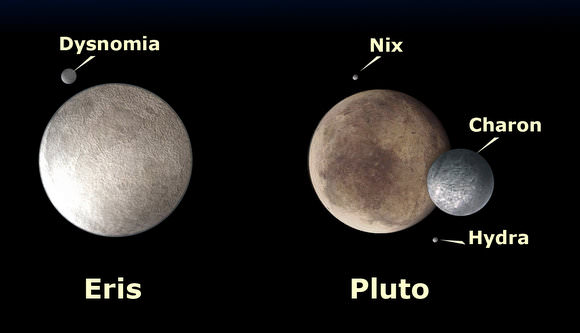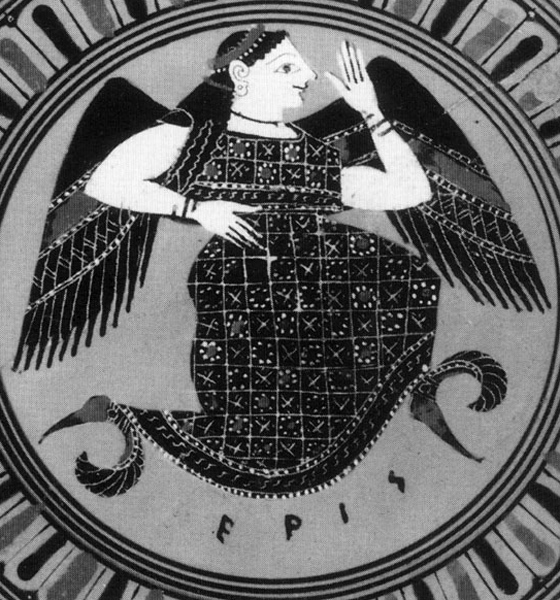Mike Brown's Planets wrote:
The shadowy hand of Eris
Mike Brown: 07 Nov 2010 12:46 PM PST
<<Eris, the goddess of discord and strife and the most massive dwarf planet, is up to her usual tricks. On Friday night Eris was predicted to pass directly in front of a relatively faint star in the constellation of Cetus. You might think that this sort of thing happens all of the time, but you’d be wrong. Eris is so small in the sky and stars are such tiny points of light that, though they get close frequently, their actually intersections are rare. When they do intersect, though, something amazing happens: the star disappears. And since we know how fast Eris is moving across the sky, seeing how long the star disappears gives us a very precise measure of the size of Eris. Or, to be more exact, a very precise measure of a single chord passing through the body.
Predicting that such an event is going to take place is a lot of hard work. Teams of astronomers around the world continuously measure and refine the orbit of Eris (and other objects out in the Kuiper belt) and carefully pinpoint the positions of stars potentially in its path. When a collision (ok, “occultation” is the right word here) looks possible, more and more effort is put into better understanding the precise location of the star and alerts go out throughout the world to try to watch a disappearing star.
The predicted size and path of the shadow of Eris. South America was the mostly likely location to make a good detection, but the uncertainties in the position of Eris and the star might have put the shadow as far north as N. America or even down in Argentina.
There is one important catch. Even if every single telescope in the world were watching, most would not see a thing. That’s because Eris is so small that if it is blocking the star from one spot on the earth it is not blocking it from most others. The easiest way to think of this is to imagine that that one star being occulted is the only star in the entire sky and it is super bright. As Eris moves in front of the star it makes a shadow on the earth, and that shadow is the size of Eris itself. Eris has a diameter about 5 times smaller than that of the earth, so the shadow covers an area something like 5 times 5 = 25 times smaller than the earth itself. It’s not quite that bad, though, because, like a lunar eclipse, the shadow of Eris sweeps across the face of the earth, making a track that looks something like the picture here.
It’s hard enough knowing that Eris is going to occult the star. Knowing precisely where on earth to be to see the occultation is even harder. So on Friday night, dozens of astronomers from Europe, South America and North America all watched one little spot in the sky to see if a faint star would disappear. I gave it a try myself from my robotically controlled 0.6 meter telescope at Palomar Observatory (which I operated remotely while making dinner for me and Lilah), though the star was so low in a still-bright evening sky at the time of the predicted occultation that I wouldn’t have been able to tell one way or another if anything happened. Dozens might seem like a large number of astronomers, but it’s not enough to blanket the entire earth; there were gaps between telescopes where the shadow could pass and we would never know. We would require some luck. And, happily, we got lucky.
The first positive report came from Sebastian Sarabia, Alain Maury and Caisey Harlingten at the San Pedro de Atacama Celestial Explorations Observatory in Chile, who saw the star disappear for 76 seconds. Later it was reported that Emmanuel Jehin at the TRAPPIST telescope, about 700 km south in La Silla Chile also saw the star disappear. This means we’re in business. While each single detection gives you only one chord across the body, it only takes two different chords to precisely define the size of a circle. And since we are pretty certain Eris is massive enough to be spherical (Pluto, only 80% the mass of Eris, is spherical), that means a size can be measured.
Yes! This is huge! Most of the ways we have of measuring the sizes of objects in the outer solar system are fraught with difficulties. But, precisely timed occultations like these have the potential to provide incredibly precise answers. The earliest measurement came from trying to infer the size of Eris by measuring the total amount of heat coming from it, kind of like closing your eyes and holding your hold out and trying to tell the difference between a small flame and a huge bonfire next to you. Those early results – as you might guess -- had large uncertainties but suggested a diameter of 3000 km with an uncertainty of 400 km, making it comfortably larger than Pluto, with a radius of about 2300 km. Soon after, my students and I obtained some beautiful images with the (now, sadly, defunct) High Resolution Camera on the Hubble Space Telescope. These images allowed us to (just barely) measure the size of the tiny disk of Eris. We found that our best measurement gave Eris a diameter of 2400 km with an uncertainty of 100 km. This means that Eris is, within the uncertainties, more or less the same size as Pluto! Later measurement of the orbit of Dysnomia showed that Eris is a 25% more massive than Pluto, so, still a more substantial body, but their sizes could be remarkably similar. Of course, if they are the same size by Eris is more massive that must mean that Eris contains considerably more rock in its interior than Pluto. I can’t think of any good reason for this to be true, so my best guess for the past few years has been that Pluto and Eris have similar interiors and that Eris is 25% more massive because it is 7% larger. That would suggest a diameter for Eris around 2480 km, which is well within our measurement uncertainties and not too far off of the thermal measurements. If you had asked me to bet on Eris’s true size a week ago, this is what my bet would have been. I would even have bet a lot of money. Too bad you didn’t take that bet a week ago, because you could have won some money.
The preliminary results from the two occultation detections suggest that Eris is on the smaller end of our uncertainty range. Indeed, Bruno Sicardy, who masterminded the entire worldwide attempt to detect these occultations, suspects that Eris can be no bigger than 2320 km across. Sadly, the uncertainties in these occultation measurements are larger than they might have been; the only detections of the occultations came from fairly small telescopes, which means that to detect the faint star they had to take long exposures. Long exposures mean that you don’t know as precisely when the star appeared and disappeared. With the success of these observations, though, bigger telescopes are now likely to try to get in on the action. One or two good occultations with big telescopes taking fast data, and we will know the diameter a Eris even better than we currently know the diameter of Pluto. I can’t wait.
Though the results from Friday are preliminary and not as precise as I would like, it is still fun to speculate on what they might mean. If these preliminary results stand up, Eris and Pluto are very different bodies. Though Eris is substantially more massive, they are essentially the same size. Eris must be made almost entirely of rock with a little coating of frost – which we see – on the outside. How could Eris and Pluto look so similar in size and exterior composition yet be totally unalike on the inside? As of today I have absolutely no idea. Two other large objects in the outer solar system – Haumea and Quaoar – also appear to be mostly rocky with a little ice on the outside. In the past we’ve been willing to make up special explanations for them. But Eris, too? Having to continue making up special explanations is becoming unpalatable. Something is going on in the outer solar system, and I don’t know what.
What’s next? We are all eagerly awaiting a more precise analysis of the results to see what they really show. Eris reveals her secrets slowly, but we now already know so much more about that little world than we did on that moment in January 2005 when we first saw her crawling across the sky. And there will be more to come. We don’t yet know when or where, but, once again, some astronomer will be watching a faint star in the constellation of Cetus suddenly blink out as the next shadow of Eris crosses the face of the earth and the exploration of the most massive dwarf planet will continue. >>



